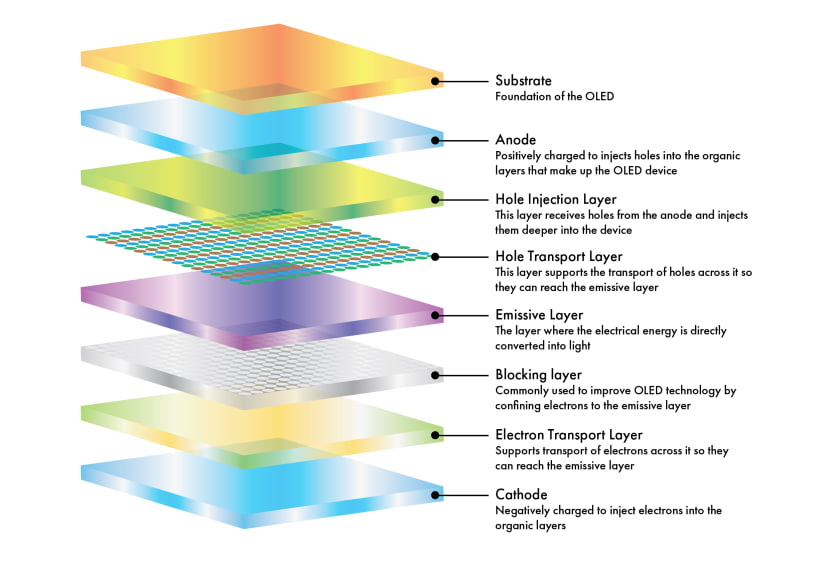All you need to know about OLEDs
Follow articleHow do you feel about this article? Help us to provide better content for you.
Thank you! Your feedback has been received.
There was a problem submitting your feedback, please try again later.
What do you think of this article?
If you have anything at all to do with tech, you will have come across OLED displays. Commonly used in TVs, tablets, and laptops, but how much do you really know about OLEDs? Well, here is all you need to know about how they work and their pros and cons.
OLED stands for organic light-emitting diode. It is a carbon-based LED (Light Emitting Diodes) technology that greatly differs from standard LED technologies. Whereas standard LEDs are small single-point light sources made of semi-conductor layers, OLEDs are produced in sheets creating diffused-area light sources. OLEDs are typically thinner and brighter than standard LEDs, enabling more flexibility.
An OLED is a solid-state device within which electrons and holes are produced from layers of carbon film, or ‘organic material’, that sits inside the OLED panel sandwiched between two thin-film conductive electrodes, behind the glass screen. When an electric current is passed through this layer of organic compound, it emits its own light. The light intensity will be determined by the amount of current applied by the electrodes. Operating in this way eliminates the requirement for a backlight, like those found in liquid crystal displays (LCDs). A standard LCD will typically have an LED backlight that sits uniformly across the entire back of the LCD screen.
For light to successfully pass through and emit out from an OLED, one of the electrodes must be transparent. Depending on the device this can be the anode or cathode. The colour of light emitted is established by the type and configuration of emissive material in use.
- Single-stacked: This is the simplest design and lowest-cost configuration. It only used 1,2, or 3 emitters to create colour and white light.
- Stacked: This method produces white light in every pixel and then applies a colour filter to create red, green, and blue sub-pixels. It is a slightly more complex structure than single-stacked and can increase the brightness of the OLED without needing to increase the current density.
- Side-by-side striped: Typically, the preferred approach for high-resolution displays such as on mobile phones. This configuration further allows for colour tunability. The sub-pixels red, green, and blue will sit side-by-side within each pixel of the display.
Because OLEDs are so thin and provide such sharp contrast with wide viewing angles, they are ideal for applications like TVs and mobile phones. OLED TVs provide higher image quality, as well as lower power consumption. In an OLED TV, the individual pixels produce light, and so when certain pixels are not needed, they can be individually turned off to achieve perfect blacks. OLED screens can even be curved, enabling all sorts of interesting applications such as LG’s ‘Wallpaper TVs.’ There is even ongoing research into creating transparent and flexible OLED screens
OLED advantages
- OLEDs offer a flexible solution that widens design possibilities. They can be manufactured into most shapes and sizes. As well as being mounted onto flexible substrates or transparent surfaces, to emit light from both sides of the screen.
- Due to their lack of an external backlight, OLEDs are more energy-efficient to run than LCDs. Additionally, because individual pixels can turn off as needed, this means that OLED screens consume less power when operating.
- OLED displays are very thin, enabling a more visually pleasing product as well as a lighter-weight solution which can be easily mounted to the desired surface.
- Sharp contrast and crisp multi-colour displays can be achieved with OLED. True blacks are enabled, and fast smooth colour transitions. The diffused light emitted from OLED displays allows them to be used close to the top surface of the screen, without creating glare.
OLED disadvantages
- The lifetime of OLEDs is one of their key drawbacks. OLED lifetime is greatly reduced at elevated temperatures, it is much more suited to low ambient conditions. This is made more complex as a lifetime of pixels can differ depending on the assorted colour usage. Blue colours tend to have a lower lifetime than other colours such as yellow, which can lead to having to replace displays more frequently than desired.
- Sticky pixel (also known as image retention) occurs when an image or sequence is repetitively played on a screen. It refers to the permanent mark that can be left by damaged pixels caused by this repetitive use. Although this only typically arises when using a screen for a constant and continuous purpose such as display advertisement in a retail store.
- Another large drawback is the price of OLEDs. They are not cheap to produce, particularly when using more complex configurations. Because of this, realistically, OLEDs are still years away from widespread use for general illumination.



